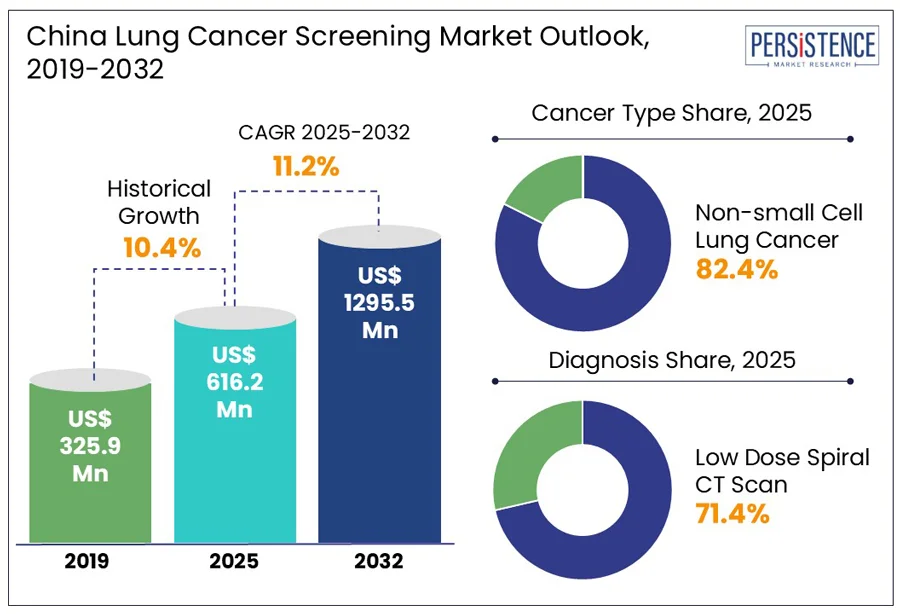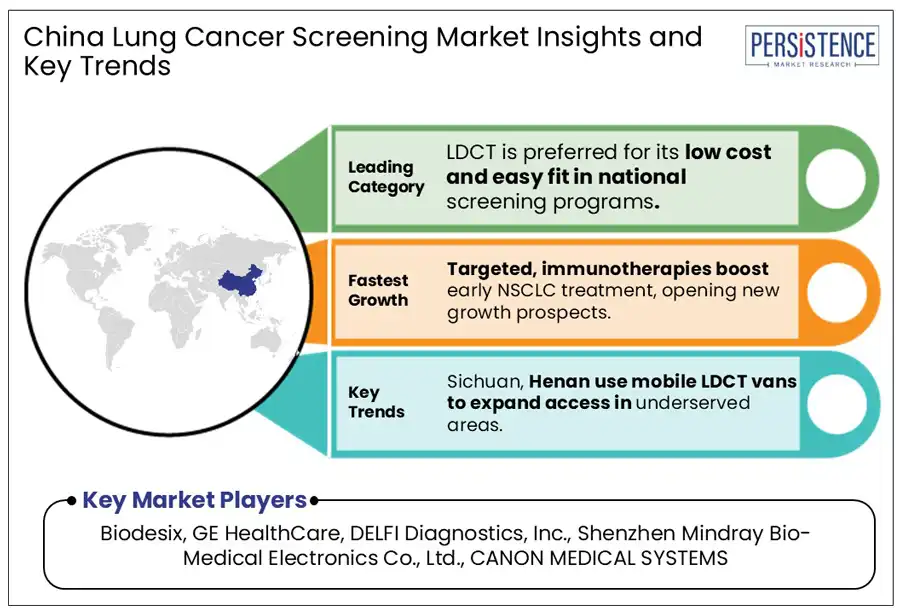ID: PMRREP35427| 147 Pages | 17 Jun 2025 | Format: PDF, Excel, PPT* | Healthcare

The China lung cancer screening market size is predicted to reach US$ 1,295.5 Mn in 2032 from US$ 616.2 Mn in 2025. It will likely witness a CAGR of around 11.2% in the forecast period between 2025 and 2032.
In China, lung cancer remains one of the deadliest malignancies, claiming over 700,000 lives annually. Despite significant medical innovations, the disease is still largely diagnosed at advanced stages, where curative treatment options are limited. This urgent scenario has pushed lung cancer screening to the forefront of national health policy, with Low-Dose Computed Tomography (LDCT) emerging as a promising tool to shift diagnosis toward early stages.

Key Industry Highlights:
|
Market Attribute |
Key Insights |
|
China Lung Cancer Screening Market Size (2025E) |
US$ 616.2 Mn |
|
Market Value Forecast (2032F) |
US$ 1,295.5 Mn |
|
Projected Growth (CAGR 2025 to 2032) |
11.2% |
|
Historical Market Growth (CAGR 2019 to 2024) |
10.4% |
Regulatory bodies are anticipated to significantly bolster the China lung cancer screening market growth through 2032 with guideline development, funding mechanisms, technological facilitation, and policy formulation. From 2020 to 2022, China’s National Cancer Screening Program (NCSP) extended guidelines based on domestic multicenter RCTs and real-world pilot studies. It formally incorporated lung cancer alongside cervical, breast, colorectal, and stomach cancers. Provincial and municipal programs have since received top-down guidance to implement LDCT screening for high-risk groups, effectively making it part of basic public health services.
During the annual sessions of the National People’s Congress and CPPCC, lawmakers have pushed to include cancer screening, including lung cancer, in public insurance coverage. Though the existing government funding covers only one-time high-risk screening, it represents a conscious step toward sustainability. Rather than importing global protocols, regulators emphasized China-specific data such as unique demographic trends, high adenocarcinoma rates in non-smokers, and aging patterns. This China-centric validation has facilitated a wide acceptance among practitioners and insurers.
Participation in China’s Low-Dose CT (LDCT) lung cancer diagnostics remains significantly uneven, limiting the impact of early detection programs. A Henan-based program (2013 to 2019) invited 55,428 high-risk individuals, but only 22,260 completed LDCT screening, highlighting low compliance despite free scans. Contributing factors include out-of-pocket costs for follow-ups, distrust in healthcare institutions, paid leave from work, and low health literacy, specifically among less educated and male populations.
High false-positive rates further discourage participation and strain healthcare resources. In a nationwide cohort with 1.02?Mn enrolled, 79,581 underwent LDCT, with 5,165 flagged for nodules; only 149 were actual lung cancers. That equates to an astounding 68.8% false-positive rate, a burden that necessitates additional imaging, invasive procedures, and chemotherapy drugs. The resulting anxiety, logistical challenges, and financial burden of follow-up imaging or biopsies discourage initial and repeated screening.
The incorporation of AI in image analysis is predicted to create lucrative opportunities in the field of lung cancer supportive care products in China, finds Persistence Market Research. A pioneering real-world study at Sichuan University’s West China Hospital, featuring Hangzhou Yitu’s AI analysis on low-dose CT scans, showed that AI-assisted detection outperformed conventional methods. The system detected nodules with over 93% accuracy for Lung-RADS risk categorization. It also effectively differentiated nodules with 92 to 94% precision and is now deployed across 166 hospitals in China.
A recent research study using 3D deep learning models on CT scans reported a sensitivity of 75%, specificity of 82%, and diagnostic accuracy of 89%. Another model named CMixNet achieved even higher performance, with 94% sensitivity and 91% specificity on standard datasets. Contrasting with programs in the West that target heavy smokers, China’s accessible, insurance-backed low-dose CT initiatives are identifying early-stage adenocarcinomas in younger, non-smoking women. These cancers are being detected at stage 0 or I, thereby enhancing survival prospects.
Based on cancer type, the market is bifurcated into Non-small Cell Lung Cancer (NSCLC) and Small Cell Lung Cancer (SCLC). Among these, NSCLC is projected to hold nearly 82.4% of the China lung cancer screening market share in 2025 as the country documented approximately 820,000 new lung cancer cases in 2020, with NSCLC forming the overwhelming majority. Adenocarcinoma, a subtype of NSCLC, has overtaken squamous cell carcinoma as the most prevalent histology in the country. These tumors often present as ground-glass nodules or small peripheral lesions, which are readily detectable by low-dose CT scans.
SCLC, on the other hand, will likely exhibit a considerable CAGR from 2025 to 2032 amid its increasing prevalence in provinces such as Hebei. Smoking remains the main driver of SCLC in China, similar to global patterns. Case-control and registry studies note strong male predominance, consistent with the country’s high smoking rates. As SCLC grows rapidly and metastasizes early, it is mainly diagnosed symptomatically at late stages, missing the window for curative intervention.
In terms of diagnosis, the China lung cancer screening market is divided into low dose spiral CT (LDCT) scan and chest X-ray. Out of these, LDCT scan is estimated to account for approximately 71.4% share in 2025, owing to its high detection capability, accessibility, and cost-efficiency. China’s National Lung Cancer Screening (NLCS) program leverages arranged transport and media campaigns to enhance LDCT uptake. As of recent analysis, 33% of high-risk participants completed scans, and communities with shorter delay times exhibited significantly higher compliance.
Chest X-ray (CXR) is speculated to remain a key diagnostic tool as community-wide surveys in Sichuan province show that including it in routine health check-ups raises public familiarity with lung cancer screening nearly 1.6-fold. This increased awareness is important for engaging population who often tend to shift toward more precise modalities such as LDCT. Economic modeling comparing LDCT with CXR in urban smokers indicated that while LDCT reduced lung cancer mortality by 24.2% versus no screening, its advantage over CXR was just 17.2%. This highlights the role of CXR as a benchmark and calibrator for new screening technologies.

Shandong province presents a particularly heavy burden of lung cancer, which has shaped its screening landscape in distinct ways. In 2018, Shandong reported an Age-Standardized Incidence Rate (ASIR) of 42.56 per 100,000 and a mortality rate of 29.77 per 100,000, both above the national averages of 38.23 and 27.18, respectively, as found in a study published in Frontiers. The province has experienced considerable growth in lung cancer incidence and death rates across China.
Bayesian age-period-cohort modeling forecasts that lung cancer mortality will continue rising through 2030, underscoring the urgency of effective screening and early detection interventions. China’s 2023 LDCT lung cancer screening guideline, which was adopted nationally, including in Shandong, recommends baseline LDCT for individuals aged 50 to 75 with ≥20 pack-year smoking history or other risk factors. Scan optimization parameters are standardized, and follow-ups are annual or biennial based on results.
The scenario of lung cancer screening in Sichuan province reveals several unique regional features and recent developments. More than 95% of high-risk individuals in the province can reach LDCT screening within 60 minutes, and 16.6% can walk to a facility within 30 minutes, reveals a study published in the National Library of Medicine. Spatial inequity, however, is significant as urban eastern areas have much better access and shorter travel times than rural western and ethnic minority areas.
Accessibility to municipal and provincial-level hospitals accounts for only 22.9%, compared with 38.7% for county-level institutions. Province-wide surveys show only 34.7% of high-risk adults in Sichuan undertake the recommended annual LDCT scan. This uptake, though superior to the U.S. 2017 rate, still falls well short of the 95% threshold deemed necessary for mortality reduction as per NLST evidence. According to The Lancet, the use of media campaigns, navigation assistance, and express diagnostic services is linked to 5 to 6 percentage point increases in uptake.
A multicenter cohort covering both developed and developing provinces, including Jiangsu, reported that developed areas had significantly higher LDCT screening uptake. Standardized uptake in Jiangsu and similar provinces consistently outperformed rural provinces. Age-period-cohort modeling shows that lung cancer incidence in Jiangsu has surged steadily over the past decade, propelled by aging population. Projections, however, indicate a plateau or modest decline through 2030, primarily among males and rural residents, while rates among females and urban dwellers remain stable.
Such epidemiological shifts help develop screening focus zones, specifically city centers and high-risk female populations exposed to indoor pollutants. Being among the first to integrate the NLCS framework, Jiangsu supports media outreach, navigation assistance, and expedited follow-up pathways. Structural improvements, including providing transportation and reducing scan wait times, appear as more stable in this province.
China lung cancer screening market houses several public health institutions, start-ups, and well-established domestic as well as international medical imaging companies. Leading companies are competing with global leaders in providing Low-Dose Computed Tomography (LDCT) solutions, the gold standard for early lung cancer detection. At the same time, domestic companies offering government-backed, affordable technologies are rapidly scaling local production capabilities. Provincial disparities in healthcare access are further creating niche opportunities for mobile CT solutions and tele-radiology platforms.
The market is projected to reach US$ 616.2 Mn in 2025.
Surging prevalence of NSCLC and implementation of various national health policies are the key market drivers.
The China lung cancer screening market is poised to witness a CAGR of 11.2% from 2025 to 2032.
Expanding screening access to non-smokers and insurance coverage for LDCT are the key market opportunities.
Biodesix, GE HealthCare, and DELFI Diagnostics, Inc. are a few key market players.
|
Report Attribute |
Details |
|
Historical Data/Actuals |
2019 - 2024 |
|
Forecast Period |
2025 - 2032 |
|
Market Analysis Units |
Value: US$ Bn/Mn, Volume: As Applicable |
|
Geographical Coverage |
|
|
Segmental Coverage |
|
|
Competitive Analysis |
|
|
Report Highlights |
|
|
Customization and Pricing |
Available upon request |
By Cancer Type
By Diagnosis
By End-use
By Province
Delivery Timelines
For more information on this report and its delivery timelines please get in touch with our sales team.
About Author